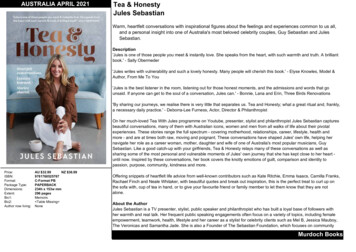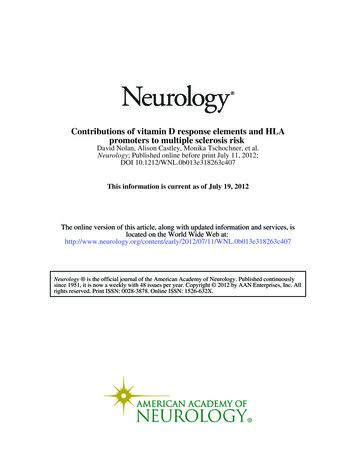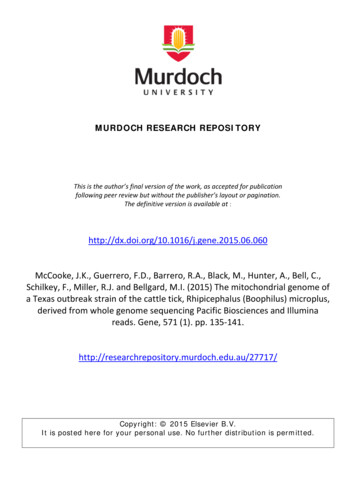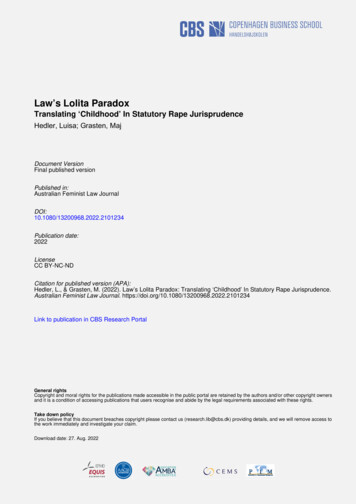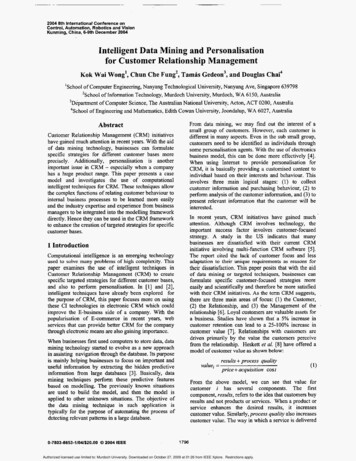
Transcription
2004 8th Intematlonaf Conference onControl, Automation. Robotics and VisionKunming, China, 6-9th December 2004Intelligent Data Mining and Personalisationfor Customer Relationship ManagementKok Wai Wong', Chun Che Bung', Tamas Gedeon3, and Douglas Chai4'School of Computer Engineering, Nanyang Technological University, Nanyang Ave, Singapore 639798'School of Information Technology, Murdoch University, Murdoch, WA 6150, Australia3Department of Computer Science, The Australian National University, Acton, ACT 0200, Australia4School of Engineering and Mathematics, Edith Cowan University, Joondalup, WA 6027, AustraliaFrom data mining, we may find out the interest of asmall group of customers. However, each customer isdifferent in many aspects. Even in the sub small group,customers need to be identified as individuals throughsome personalisation agents. With the use of electronicsbusiness model, this can be done more effectively [4].When using Internet to provide personalisation forCRM, it is basically providing a customised content toindividual based on their interests and behaviour. Thisinvolves three main logical stages: (I) to collectcustomer information and purchasing behaviour, (2) toperform analysis of the customer information, and (3) topresent relevant information that the customer will beinterested.AbstractCustomer Relationship Management (CRM) initiativeshave gained much attention in recent years. With the aidof data mining technology, businesses can formulatespecific strategies for different customer bases moreprecisely. Additionally, personalisation is anotherimportant issue in CRM - especially when a companyhas a huge product range. This paper presents a casemodel and investigates the use of computationalintelligent techniques for CRM.These techniques allowthe complex functions of relating customer behaviour tointema1 business processes to be learned more easilyand the industry expertise and experience fiom businessmanagers to be integrated into the modelling frameworkdirectly. Hence they can be used in the CRM frameworkto enhance the creation of targeted strategies for specificcustomer bases.In recent years, CRM initiatives have gained muchattention. Although C R M involves technology, theimportant success factor involves customer-focusedstrategy. A study in the US indicates that manybusinesses are dissatisfied with their current CRMinitiative involving multi-function CRM software [5].The report cited the lack of customer focus and less1 IntroductionComputational' intelligence is an emerging technologyused to solve many problems of high complexity. Thisadaptation to their unique requirements as reasons forpaper examines the use of intelligent techniques inCustomer Relationship Management (CRM) to createspecific targeted strategies for different customer bases,and also to perform personalisation. In [I] and [2],intelligent techniques have already been explored forthe purpose of CRM, this paper focuses more on usingthese CI technologies in electronic CRM which couldimprove the E-business side of a company. With thepopularisation of E-commerce in recent years, webservices that can provide better CRM for the companythrough electronic means are also gaining importance.their dissatisfaction. This paper posits that with the aidof data mining or targeted techniques, businesses canformulate specific customer-focused strategies moreeasily and scientifically and therefore be more satisfiedwith their CRM initiatives. As the term C R M suggests,there are three main areas of focus: (1) the Customer,(2) the Relationship, and (3) the Management of therelationship [6]. Loyal customers are valuable assets fora business. Studies have shown that a 5% increase incustomer retention can lead to a 25-100% increase incustomer value [7]. Relationships with customers aredriven primady by the value the customers perceivefrom the relationship. Heskett et al. [8] have offered amodel of customer value as shown below:When businesses first used computers to store data, datamining technology started to evolve as a new approachin assisting navigation through the database, Its purposeis mainly helping businesses to focus on important anduseful information by extracting the hidden predictiveinformation from large databases [3]. Basically, datamining techniques perform these predictive featuresbased on modelling. The previously known situationsare used to build the model, and then the model isapplied to other unknown situations. The objective ofthe data mining technique in such application istypically for the purpose of automating the process ofdetecting relevant patterns in a large database.0-7803-8653 1/041 20.000 2004 IEEEresults process qualityvaluei price acquisition cost(1)From the above model, we can see that value forcustomer i has several components. The firstcomponent, results, refers to the idea that customers buyresults and not products or services. When a product orservice enhances the desired results, it increasescustomer value. Similarly, process quality also increasescustomer value. The way in which a service is delivered1796Authorized licensed use limited to: Murdoch University. Downloaded on October 27, 2009 at 01:26 from IEEE Xplore. Restrictions apply.
is often as important as the result itself. Price is also acomponent of customer value but not the onlycomponent. The costs of acquiring a product or servicecan sometimes overshadow the price itself. Data miningtechnology can enhance the understanding of differentcomponents of customer value as well as the needs andbackground of the customer. Different components ofcustomer value provide opportunities for enhancementand management of the relationship with individualcustomers. From (l), we can see that value is defined atthe individual IeveI (hence the subscript i). Therefore itis important to identify the components of value that areunique to each customer or customer base in order tocreate unique value propositions to that customer baseand manage those relationships appropriately.Tn this paper, data mining and personalisation tool usingintelligent techniques are proposed in part of the CRMbuilding block.I2 C R M ModelIn this section, we propose 3 CRM model that canfacilitate the use of E-commerce. After the proposedCRM model has been discussed, intelligent data miningtechniques that can aid the formulation of the CRMstrategy will be presented in the subsequent sections. AsCRM model for this application could be a verycomplex model, the strategy behind may be manifold.Consequently, we limit the scope of this paper bypresenting only the modules that serve the purpose ofproviding personalisation using E-commerce. Thepurpose of the model is to assist the organisation orbusiness in developing some forms of CRM strategythat could effectively provide personalised service. Weemphasise that this model is strictly developed for thisresearch, and the authors have no intention of copyingany existing model.One method of identifying components of value andopportunities for relationship enhancement is theidentification of customer segments. In marketingresearch, this is normally known as marketsegmentation [SI. Market segmentation breaks down aheterogeneous market into a number of smallerhomogeneous markets where special treatment and carecan be used to address a more precise satisfaction factorof the customer needs. Segmentation can normally beclassified as a-priori and post-hoc approaches [lo]. InCRM, the market to be segmented is the customer base.The building blocks of the CRM model provide aframework to deliver value to the customer andprofitability to the company. This framework starts withdifferentiating customers along two dimensions, by thecustomers’ value to the fm, and by their wants andneeds. The first dimension focuses on customervaluation measurement by understanding the value acustomer represents to the company. This measurementidentifies revenue growth potential from repeatpurchases, referrals, and expanding scope of business.The second dimension looks at the customer preferenceto determine what are the wants and needs of customers,i.e., the customer value proposition. This measurementexamines the results that a customer is hying to achieve,and determines whether the company can bundleproducts to deliver the results. This could also be able totranslate to some IeveI of personalisation in theE-commerce environment.In order to understand a customer, the process has tostart by analysing all the relevant data belonging to thecustomer. Thus, data mining techniques can beconsidered as the intelligence behind a successful CRMstrategy [6]. This technology is to transform’data intouseful information for a business to- focus on itscustomers. There are basically two main types of datamining: descriptive and predictive. Descriptive datamining generates information about the data so that wecan realise some interesting underlying information.Predictive data mining makes use of past patterns andinformation in predicting what a customer will buy inthe future.There are five main steps in the process ofimplementing a successful data mining solution forCRM 1111: setting goals, data collection, datapreparation, analysis and prediction, and measurementand feedback. During goals setting, identification of themarket segmentation model is important. Proper goalsunder each segment will permit a more precise addressof issues such as retention, risk avoidance as well aspossible cross selling. In data collection andpreparation, it is important to address issues like featureselection, parameter identification and handling ofmissing data. When building analysis and predictionmodels, different methods may have to be used in eachsegment in order to meet the intended goals. A crucialpoint in gaining business confidence in establishing amodel is to avoid a total “black box” method thateliminates the contributions of the expert in thebusiness.Our proposed model aims to integrate two main aspectsof the CRM, which are intelligent data mining andpersonalisation, in order to provide personaIisedservices by recommending products or services whichthe customer will most likely be interested in. The mainobjectives of the integration can be divided into three.main categories: market segmentation and productmatching, customer preference learning, and productfiltering.In a CRM data mining model, the first step is to collectknowledge from the past and.existing customers so thattheir wants and needs can be studied. This fmt stage ofthe CRM model is to perform segmentation in the largepool of customer profiles within the data warehouse.This data warehouse normally contains informationabout the customer, information gathered via purchasemade, surveys, as well as other point of contactsinformation. ARer segmentation of the large data1797Authorized licensed use limited to: Murdoch University. Downloaded on October 27, 2009 at 01:26 from IEEE Xplore. Restrictions apply.
classification is performed to extract the more relevantdata marts for better personalisation.warehouse, it is possible to identify a few smallergubsets. Ideally, after the initial segmentation, thesubsets data pool will be more homogeneous withineach segment, which is more suitable for target analysis.Beside the data warehouse that contains customerprofiles, there will be another data warehouse that isspecially used to store information about products orservices provided by the company. Some automaticallygenerated rules and may be human interaction andanalysis is required at this stage to perform someproduct matching. Normally, in this step, the humananalyst will atso take away any input variables that areirrelevant to the objectives. For example, input variablessuch as Post Codes, Address etc may not be very usefulfor some subgroup of the data mart, Figure 1 gives agraphical illustration of this data mining stage of theCRM model.When a customer is interested in purchasing a productor searching for a product, an intelligent agent willsearches through the data marts based on the customerpreference learned. Based on the products attributes andcustomer's preference, a filter is used to select thoseproducts that the customer are most likely to beinterested. It is then presented to the customer in such away that the higher ranked products will appear to thecustomer first.Dsts.P.rrhouss(customffPmlac5 mdUFigure 2: Customer personalisation for the CRM model.3 Computational Intelligence3.1 Artificial Neural NetworksFigure 1: Data mining for the CRM model.After the data warehouses have been merged and brokendown into data marts, these data marts will be used inthe personalisation module of the CRM as shown inFigure 2. When customers first register, based on theinformation collected from the registration process, thecustomers will be pre-classified according to theknowledge generated from the previous data miningmoduIe. Every time when a particular customer logs inwith their account, the relevant data marts will beidentified as the infomation that the personalisedsystem will work on. This will speed up thepersonalisation process by working on a subgroup of themass amount of the data.In the last decade, Artificial Neural Networks (ANNs)have emerged as a useful option for inferential dataanalysis and solving complex data analysis problem.The observation sample that is used to derive thepredictive model is known as training data in ANNdevelopment. The independent variables, or thepredictor variables, are known as the input variables andthe dependent variables, or the responses, are known asthe output variables.In supervised learning, an ANN makes use of the inputvariables and their corresponding output variables tolearn the relationship between them, Once therelationship is found, the trained ANN is then used topredict new output variables given new input data set.Back propagation Neural Network (BPNN) as shown inFigure 3 is the mast widely used neural network systemand the most well known supervised learning technique[12]. Back propagation is a systematic method fortraining multilayer ANN. It has been implemented andapplied successfully to various problems. A basicBPNN consists of an input, an output and one or morehidden layers. Each layer is made up of a number ofneurons that are connected to all the neurons in the nextlayers. However, the output layer will only generate theresults of the network.Beside this pre-classification of the customers whenthey registered, a customer preference learning modulewill learn the customers' profile online. Every time,when a customer interacts with the E-business site, thepreference gathers by his behaviour will be logged.From this logbook, the customer preferences like price,quality, and brand can be learned. At. the end, i-ankingson the products will be performed and save in a ,database. The information on the database is then usedto verify the pre-classification stage, and if necessary re-1798Authorized licensed use limited to: Murdoch University. Downloaded on October 27, 2009 at 01:26 from IEEE Xplore. Restrictions apply.
consisting of input vectors x [Xr,X2,.,XjT,i.e. x E i ",can be visuaIised as being connected to ail nodes inparallel via a scalar weight pF The aim of the learningis to map all the n input vectors X, onto mi by adjustingweights pi such that the SOM gives the best matchresponse locations.The objective of training BPNN is to adjust the weightsso that application of a set of inputs will produce thedesired set of outputs. A training set containing anumber of desired input and output pairs is used. Theinput set is presented to the input layer of BPNN. Acalculation is carried out to obtain the output set byproceeding from the input layer to the output layer.After this stage, feed forward propagation is done. Atthe output, the total error (the sum of the squares of theerrors on each output cell) is calculated and then backpropagated through the network. The total error, E, canbe calculatedusing:E K 1NLc(- E [ U k )- 0; (WI2 1k l 2 i l(2)where K is the number of pattems, L is the layernumber, T is the expect target, and U is the actualoutput.Figure 4: Visualisation of self organising map.It can also be said that SOM is a nonlinear projection ofthe probability density function p ( 4 of the highdimensional input vector space onto the twodimensional display map. Normally, to find the bestmatching node i, the input vector X is compared to allreference vector mi by searching for the smallestEuclidean distance:11 X- m,11, indexed by c,i.e., 11 x - m , II min 11 x - m iI(3)During the learning process, the node that best matchesthe input vector X is allowed to learn. Those nodes thatare close to the node up to a certain distance will also beallowed to learn. The learning process is expressed as:Figure 3: Back propagation neural network.A modification of each connection weight is done andnew total m o r is calculated. "his back propagatedprocess is repeated until the total error value is belowsome particular threshold. At this stage, the network isconsidered trained. After the BPNN ha5 been trained, itcan then be applied to predict other cases.m , ( t I ) m i ( t ) h c , ( t ) [ X ( t ) - m j ( t ) ](4)where t is a discrete time coordinate, and h,,(t) is theneighbourhood function.After the learning process has converged, the map willdisplay the probability density function p(2J that bestdescribes all the input vectors. At the end of the learningprocess, an average quantisation error of the map will begenerated to indicate how well the map matches theentire input vectors X,.The average quantisation error isdefined as:For unsupervised learning, an ANN will only make useof the input variables and attempts to arrange them in away that is meaningful to the analyst. Self-OrganisingMap (SOW is a popular unsupervised neural networktechnique mainly because it is a fast, easy and reliableunsupervised clustering technique [13]. OM isdesigned to simulate the organisation found in variousbrain structures and is related to brain maps. Its mainfeature is the ability to visualise high dimensional inputspaces onto a smaller dimensional display, usually twodimensionat as shown in Figure 4. In this discussion,only two-dimensional arrays will be of interest. Let theinput data space %" be mapped by the SOM onto a twodimensional array with i nodes. Associated with each inode is a parametric reference vector m, [pjl,pJ ., p J r E !U", where pli is the connection weight betweennode i and input j . Therefore, the input data space %"E 11X - m ,112P(X)&(5)3.2 Fuzzy TheoryFuzzy theory works on the basis derived rom fuzzy sets[15]. A fuzzy set allows for the degree of membershipof an item in a set to be any real number between 0 and1, this allows human observations, expressions andexpertise to be modelled. The membership function of afuzzy set A is denoted by:1799Authorized licensed use limited to: Murdoch University. Downloaded on October 27, 2009 at 01:26 from IEEE Xplore. Restrictions apply.
A :x3[0,1]4 Intelligent C R MIn this section we present the Computational intelligencemethods used in blocks shown in Figures 1 and 2, Thereare basically two stages in the CRM model that we haveproposed in Section 2; there are the data mining stageand the customer personalisation stage. In the datamining stage, the intelligent techniques used are similarto the one published earlier in (151. Here we summarisethe intelligent technique used as folIows.Once the fuzzy sets have been defined, it is possible touse them in constructing rules for fuzzy expert systemsand in performing fuzzy inference. Fuzzy systems canproduce more accurate resuIts based on the basic idea ofdefuzzification. A defuzzification technique is used tocalculate the conclusion by evaluating the degree ofmatches fi-om the observation that triggered one orseveral d e s in the model. This will lead to a betterresult by handling the fuzziness in the decision makingprocess. Thus, fuzzy technique can improve onstatistical prediction in certain cases.For market segmentation, SOM is used to cluster thedata warehouse. After which, the products are mappedto the SOM 2-dimensional map. The assigned productsto the customer profiles clusters generated tiom SOMwill be divided into data mart which consists of a subsetof information from the data warehouse. Fuzzy rulesextraction will be used to extract fuzzy relationshipsbetween the customer profiles and the products profiIes.With this rules, a human analyst can determine the bestway to generate the data mart.Fuzzy sets allow human expertise and decisions to bemodelled more closely. It is suggested that Fuzzy setswill play an important role in the CRM model. In thispaper, with the availabihty of vast amounts of data ineach subset, it will be useful to extract knowledge fromthe data directly. This has the advantage of discovery ofnew knowledge or relations underlying the data. Inextracting fuzzy rules from the data, the first step is totranslate all the available data into linguistic fuzzy d e susing linguistic labels. The following algorithm outlinesthe steps in extracting the fuzzy linguistic rules from theavailable data. For k inputs, the given input-output datapairs with n patterns:111222.-.ixk;Y(I,,. . . , x k ; J J(IFor the second stage of the C R M modei, the customerpersonalisation is performed through three main blocks,classifying customer, customer preference learning, andproducts filtering.When a customer first registers into the system, thecustomer will be pre-classified based on the informationcollected fiam the customer during the registrationprocess. This is done by mapping the customerinformation to the SOM generated from the datawarehouse during the data mining stage. After which,the corresponding data marts that this customer willmost probably fit in will be selected for personalisation.When the customer logs in, the customer profiIe andhistory learned during the further interaction will beused to perform the classification of the customer. Thu,this should improve the accuracies of selecting theappropriate data marts when dealing with the customer.1(7)The number of linguistics termsT and the distributionof data in the regions of the whole domain are fintdetermined. For ease of interpretation andcomputational simplicity, the shape of the membershipfunction used in this algorithm is triangular. In this case,we will obtain for every x E X ,A, EF(x) [O,lJ forallrETIn this CRM model, to reduce the complexity and toimprove interactivity, customers' ranking towardsproducts is the only content interested in the profile. Inorder to get the ranking information, customer's onlinebehaviours need to be collected and leamed. Therecording method similar to those proposed in [16] isused to collect customer's behaviour. The informationof the customer recorded for our CRM model arecustomer login ID, products ID, the number of times theproducts are shown to this customer [times], andaccumulated customer ranking on the products[occ-rank].(8)After the fuzzy regions and membership functions havebeen set up, the available data set will be mappedaccordingly. If the value cuts on more than onemembership function, the one with the maximummembership grade will be assigned to the value:After all the data sets have been assigned with a fuzzylinguistic label, Mamdani type fuzzy rules are thenformed and centroid defuzzification is used. After fuzzyrules have been generated from each data point,repeated rules are removed. In the event that there arerepeated fuzzy rules, the number of repetitions of thefuzzy rules and the firing strengths o f the rules will beexamined to resolve conflicts.The number of times that a product is shown to thecustomer is important to calculate the ranking for thecustomer. A product may be shown to a customermultiple times during one session or in multiplesessions. Whenever a product is presented to acustomer, the customer may show interest in it or ignoreit. Based on the customer's behaviour, the rank iscalculated in the following ways:1800Authorized licensed use limited to: Murdoch University. Downloaded on October 27, 2009 at 01:26 from IEEE Xplore. Restrictions apply.
When a new customer behaviour record is created,both the customer ID and product ID are set. Bothtimes and rank are initialised to zero.If the customer clicks on the product to see itsdetailed description, the rank for that product willincrease by I,.If the customer adds the product to shopping cart, therank will increase by 2.If the customer makes a purchase on the product, therank will increase by 2 again.After the customer preferences are collected, thecustomer ranking can be calculated using theformula:ace-rank rank /times(10)After the customer preference records are stored, aBPNN can be used to learn the behaviour of thecustomer. In this BPNN delegated to a customer, wewill have four inputs namely Price, Quality, Guarantee,and Brand, and the output will be ranked. As we want togive a more precise ranking, the rank generated wilI bein real number rather than integer, as it will assist ingenerating ranks of the products when preparing forproduct filtering. The filtering of the products is mainlybased on the trained BPNN for a specify customer. Theinferred rank will determine which products should befiltered. A higher rank value implies a higher chance forthe product to be preferred by the customer. Whenpresenting to the customer, the products are sortedaccording to their ranking values. The products withlow ranking values and below the threshold will befiltered out. Figure 5 gives a cross plot of the predictedranks as compared to the actual mnks collected for aspecific customer. It has shown that this intelligentCRM model could be an alternative of implement CRMstrategy suitable for E-business environment.nchFigure 5 : Cross plot of predicted ranking versus actualranking.5 ConclusionThis paper has examined the possibility o f usingintelligent techniques in the CRM model speciallydesigned by the authors for use in E-business context.The paper also highlighted two areas in a typical CRMmodel where the use of intelligent techniques canimprove the whole process. The advantage of usingintelligent techniques in CRM is that the businessanalyst can perform the CRM strategy better and at thesame time gain in-depth understanding into the CRMmodel. With the understanding of the model, the analystcan modify and add-on knowledge and experience intothe model. Furthermore, fuzzy theory can handleuncertainties in the data more efficiently than traditionaldata mining techniques.ReferencesK.W.Wong, B. Griner, W.R. Dillon, and T.D. Gedeon,“Intelligent Data Mining for Customer RelationshipManagement,” Australian J. of Intelligent lnjormafiunProcessing Systems, vol. 7, no. 1/2, pp. 64-71, 2001.K.W. Wong, “Data Mining Using Fuzzy Theory forCustomer Relationship Management,” Pruc. WesternAustralian Workshop on Information System Research,Australia, Nov. 2001.A. Berson, S. Smith, and K. Thearling, Building DataMining Applications for CRM, McGraw-Hill, 2000,pp. 123-199.S. Murugesan and A. Rammathan “Web Personalisation- An Overview,” Active Media Technology, pp. 65-76,2001.CRMGuru.com, High-Yield Marketing & MangenResearch Associates, “Multi-Function CRM S o h a r e :How good is it?” 2000.M. Nykamp, The Customer DifJerentiul:The CompleteGuide to Implementing Customer Rela-tionshipManagement, Amacon, New York, 2001.R. Riechheld, ‘The Loyalty Effect: The Hidden ForceBehind Growth, Profits and Lasting Value,” HarvardUniversity Press, Boston, 1996.J. Heskett, W.E. Sasser, and L. Schlesinger, ‘TheService Profit Chain: How Leading Companies LinkProfit and Growth to Loyalty, Satisfaction, and Value,”The Free Press, New York, 1997.M. Wedel and W.A. Kamakura Market Segmentation:Conceptual and Methodologicol Foundations, KluwerAcademic Publishers, Massachusetts, 1998.Y. Wind, “Issues and Advances in SegmentationujMarketing, vol. 15, pp. 317-337. 1978.Research,”.!.T.J. Siragusa, “Implementing Data Mining for BetterCRM,” Customer Interaction Solutions, vol. 19 no. 1 I ,pp. 38,2001D.E. Rumelhart, G.E. Hinton, and R.J. Williams,“LearningInternalRepresentation by ErrorPropagation” in Parallel Distribured frocessing, vol. I,MIT Press, Massachusetts, pp. 3 18-362, 1986.T. Kohonen, Self-Organising Map, Springer-Verlag,1995.L.A. Zadeh, ‘‘Outline a new approach to the analysis o fcomplex systems,” IEEE Trans. on Sys. Man andCybernetics, vol. I , pp. 28-44, 1973.K.W. Wong, C.C. Fung, and T.D. Gedeon “Data MiningUsing Neural Fuuy for Student RelationshipManagement,” Proc. Int, Con of So3 Computing andIntelligent Systems Tsuhba, Japan, Oct. 2002.Z. Wang and C.K. Siew “A Novel Approach toPersonalization Product Filtering in ElectronicCommerce”, Australian J. of Intelligent InfomatianProcessing Sysfems, vol7, no 3-4, pp. 81-95,2001.Authorized licensed use limited to: Murdoch University. Downloaded on October 27, 2009 at 01:26 from IEEE Xplore. Restrictions apply.
complex model, the strategy behind may be manifold. Consequently, we limit the scope of this paper by presenting only the modules that serve the purpose of providing personalisation using E-commerce. The purpose of the model is to assist the organisation or business in developing some forms of CRM strategy




